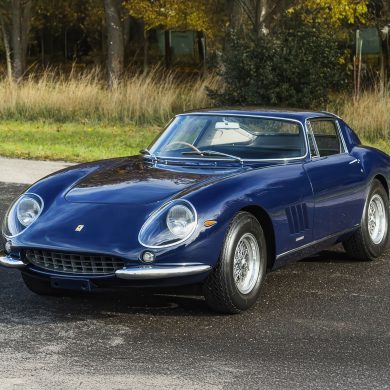Fighting a Dino with a bull
Response by Lamborghini to Ferrari 2-seater, Porsche 911 was the risky, exotic Urraco
From Dan Jedlicka, Chicago Sun-Times Auto Editor
You can’t beat Italian cars for flair and a LET’S GO! driving attitude. And two Italian automakers best known for such pizzazz are Ferrari and archrival Lamborghini, which waged car wars with a variety of models.
Most classic car fans are familiar with Lamborghini’s wild Miura and Countach sports cars with their potent V-12 engines. But the 1970-79 Urraco V-8 was an important, more practical and less costly Lamborghini. It was an answer to rival Ferrari’s small Dino two-seater and the German Porsche 911.
The Dino V-6, which was named after Enzo Ferrari’s deceased son, was built from 1967-74 and was replaced by a V-8 model with a different design. The Urraco was named after a breed of fighting bull because Ferruccio Lamborghini liked to name his cars after fighting bulls. It resulted from one of his initial plans to build a compact, potent sports car.
The Urraco debuted in 1970 with a race-car-style mid-engine layout and was a gamble for small Lamborghini with its double-overhead-camshaft 220-horsepower V-8. Most people were familiar with the automaker’s quad-camshaft 300-plus-horsepower V-12s.
Not that there was anything wrong with the Urraco’s new 2.4-liter aluminum V-8. It was up to 265 horsepower near the end of the Urraco’s production run and provided the car with stirring acceleration (0-60 mph in 7 seconds) because the Urraco was relatively light at 2,885-3,060 pounds. It could hit 143 mph.
Lamborghini one-upped the Ferrari Dino V-6 (and six-cylinder Porsche) because it had two extra cylinders. It also had a small backseat, whereas the Dino V-6 was strictly a two-seater. And the Urraco had styling from Italy’s Bertone outfit, while the Dino V-6 had been styled by that country’s somewhat less exclusive Pininfarina design firm.
Porsche had been building cars since the late 1940s, and its 911 outsold both smaller Italian automakers. Lamborghini began making autos only in the early 1960s, and Ferrari really didn’t put much effort into building road cars in respectable volumes until around 1960. But the Dino V-6 — always the most direct rival to the Urraco — found 4,027 buyers, while the Urraco grabbed only 789 customers.

The Urraco was mechanically advanced with its all-disc brake layout and all-independent suspension, although the suspension used a less costly strut design instead of more desirable and complicated double-wishbone arrangement. However, the Urraco still had excellent handling and leech-like roadholding.
The new V-8 was developed under respected chief engineer Paolo Stanzani and was less sophisticated than the Lamborghini V-12. The first 2.5-liter version of the Urraco V-8 was the same size as the Dino V-6 engine but produced 25 more horsepower. A five-speed manual transmission was standard.
The Urraco was designed by Marcello Gandini, who made no attempt to disguise the car’s fashionable mid-engine layout.
The first version of the Urraco was called the P 250. It was a sleek little car with a short, sloping hood and long wheelbase on a compact 167.3-inch-long structure. There were concealed headlights in a pointy front end and a steeply raked windshield in front of a cockpit placed far forward. The car ended up looking low, aggressive and somewhat squat. It also got a louvered engine bay/rear window area with Lamborghini Miura-like “slots,” another Gandini favorite design touch.
The Urraco was clearly an exotic sports car, but lots of initial interest was lost with the car’s production delay. Moreover, some folks were accustomed to bigger, more powerful Lamborghinis and didn’t consider it a “real” Lamborghini. It didn’t help that the Urraco suffered from poor outward vision, an offbeat driving position and marginal refinement, although it was hardly inexpensive at more than $20,000.
Quality and reliability problems soon appeared and were publicized along with Lamborghini’s escalating financial and labor problems that caused some to feel that Lamborghini might go out of business. Also, the Urraco couldn’t have arrived at a worse time for exotic sports cars because there was a major gasoline crisis and cars such as the Urraco were fuel-thirsty.
Lamborghini tried to make the Urraco more desirable with a new P 300 version, displayed at the 1974 Turin auto show in Italy. The improved model had a larger (3-liter) version of the V-8 with 265 horsepower. Its new cylinder heads were designed to offset power-robbing effects of new U.S. emissions systems, which had reduced output of the first Urraco V-8 to 180 in America. But the Urraco still had to meet new impact standards with “crash bumpers” and other weight-adding safety items.
The Urraco’s U.S. price had climbed to $22,500 in 1975. Its initially sloppy dashboard design had been improved but driveability remained a problem, as was the case with American cars that also had to meet new emissions standards. Other Urraco faults weren’t really corrected, either. 
The Urraco got a smaller (2-liter) V-8 with 182 horsepower in a new P 200 version, but it was strictly a home market “tax break” version that let Europeans escape stiff taxes on engines larger than 2 liters.
With all its problems, Lamborghini went bankrupt and fell under the control of the Italian government. The Mimram family then took over the automaker and encouraged development of the short-lived Silhouette model and much longer-lasting Jalpa.
Both were based on the Urraco and kept Lamborghini alive, along with continuing demand for the rakish, low-volume Countach. Finally, Chrysler took over the automaker in 1987 and gave it solid infusions of cash.
The Urraco wasn’t the commercial success it should have been, with less than 800 produced, but it was a genuine Italian exotic sports car and currently is valued at $28,000 to $33,600.
[Source: Chicago Sun-Times; photos courtesy of Conceptcarz.com]









